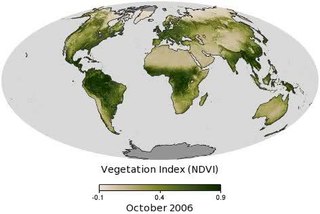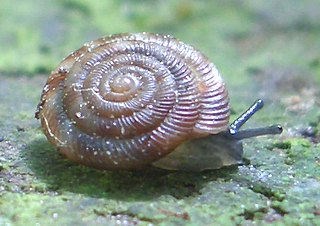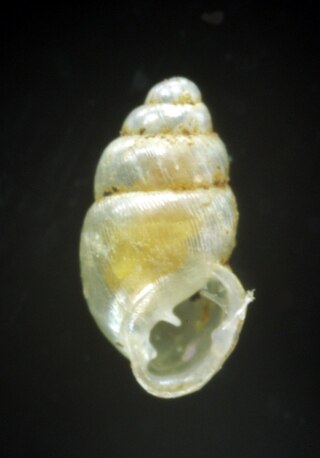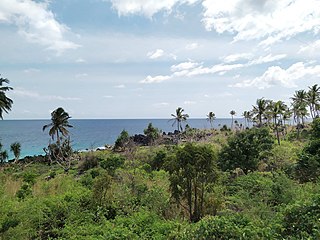Related Research Articles

A biome is a biogeographical unit consisting of a biological community that has formed in response to the physical environment in which they are found and a shared regional climate. Biomes may span more than one continent. Biome is a broader term than habitat and can comprise a variety of habitats.

Gastropods, commonly known as slugs and snails, belong to a large taxonomic class of invertebrates within the phylum Mollusca called Gastropoda.

Vegetation is an assemblage of plant species and the ground cover they provide. It is a general term, without specific reference to particular taxa, life forms, structure, spatial extent, or any other specific botanical or geographic characteristics. It is broader than the term flora which refers to species composition. Perhaps the closest synonym is plant community, but vegetation can, and often does, refer to a wider range of spatial scales than that term does, including scales as large as the global. Primeval redwood forests, coastal mangrove stands, sphagnum bogs, desert soil crusts, roadside weed patches, wheat fields, cultivated gardens and lawns; all are encompassed by the term vegetation.

The ecology of California can be understood by dividing the state into a number of ecoregions, which contain distinct ecological communities of plants and animals in a contiguous region. The ecoregions of California can be grouped into four major groups: desert ecoregions, Mediterranean ecoregions, forested mountains, and coastal forests.

Isopoda is an order of crustacean, which includes woodlice and their relatives. Members of this group are called Isopods and include both terrestrial and aquatic species. All have rigid, segmented exoskeletons, two pairs of antennae, seven pairs of jointed limbs on the thorax, and five pairs of branching appendages on the abdomen that are used in respiration. Females brood their young in a pouch under their thorax.

The Baja California desert is a desert ecoregion of Mexico's Baja California peninsula. This ecoregion occupies the western portion of the Baja California peninsula, and occupies most of the Mexican states of Baja California Sur and Baja California. It covers 77,700 square kilometers. The climate is dry, but its proximity of the Pacific Ocean provides humidity and moderates the temperature. The flora mostly consists of xeric shrubs and over 500 species of recorded vascular plants.
National Marine Conservation Areas (NMCAs) is a Parks Canada programme responsible for marine areas managed for sustainability and containing smaller zones of high protection. They include the seabed, the water itself and any species which occur there. They may also include wetlands, estuaries, islands and other coastal lands. They are protected from dumping, undersea mining and oil and gas exploration and development, which may damage the aquatic or terrestrial ecosystems in the conservation area. However, not all commercial activities are prohibited in these zones. Shipping, commercial and sport fishing, and recreational activities are allowed.

The soldier flies are a family of flies. The family contains over 2,700 species in over 380 extant genera worldwide. Larvae are found in a wide array of locations, mostly in wetlands, damp places in soil, sod, under bark, in animal excrement, and in decaying organic matter. Adults are found near larval habitats. They are diverse in size and shape, though they commonly are partly or wholly metallic green, or somewhat wasplike mimics, marked with black and yellow or green and sometimes metallic. They are often rather inactive flies which typically rest with their wings placed one above the other over the abdomen.

The Succulent Karoo is an ecoregion defined by the World Wide Fund for Nature to include regions of desert in South Africa and Namibia, and a biodiversity hotspot. The geographic area chosen by the WWF for what they call 'Succulent Karoo' does not correspond to the actual Karoo.

Punctoidea is a superfamily of air-breathing land snails and slugs, terrestrial pulmonate gastropod mollusks in the informal group Sigmurethra.

Gonidomus is a genus of air-breathing land snails, terrestrial pulmonate gastropod mollusks in the subfamily Orthogibbinae of the family Streptaxidae.

Hygromia is a genus of air-breathing land snails, terrestrial pulmonate gastropod mollusks in the family Hygromiidae, the hairy snails and their allies.

Helicarionidae is a family of air-breathing land snails or semi-slugs, terrestrial pulmonate gastropod mollusks in the superfamily Helicarionoidea.

A woodlouse is any crustacean belonging to the suborder Oniscidea within the order Isopoda. They get their name from often being found in old wood, and from louse, a parasitic insect, although woodlice are neither parasitic nor insects.

Ena montana is a species of air-breathing land snails, terrestrial pulmonate gastropod molluscs in the family Enidae.

Carychium is a genus of very small air-breathing land snails, terrestrial pulmonate gastropod mollusks in the family Ellobiidae.

The Comoros forests is a terrestrial ecoregion which covers the Comoro Islands, which lie in the Mozambique Channel between Madagascar and East Africa. These include four main islands: Grande Comore, Anjouan and Mohéli, of the Union of the Comoros, and Mayotte, a department and region of France.

Thelidomus is a genus of air-breathing land snails, terrestrial pulmonate gastropod mollusks in the family Pleurodontidae.

The Hispaniolan dry forests are a tropical dry broadleaf forest ecoregion on the island of Hispaniola. They cover 15,123 km2 (5,839 sq mi), around 20% of the island's area.
References
- ↑ Rang, Sander (1831). "Description des coquilles terrestres recueillies pendant un voyage à la côte occidentale d'Afrique, et au Brésil". Annales des sciences naturelles: 41–42. Plate 3, Fig 8.
- ↑ Bank, R. (2017). Classification of the Recent terrestrial Gastropoda of the World. Last update: July 16, 2017. . World Register of Marine Species , Retrieved 10 January 2019.